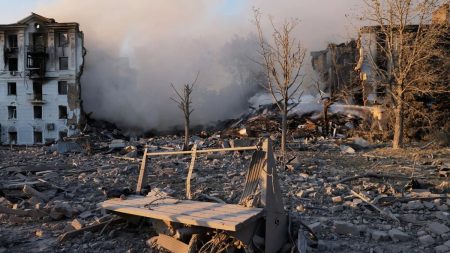The tranquility of Saturday morning, December 7th, in The Hague’s Mariahoeve neighborhood was shattered by a powerful explosion that ripped through several apartment buildings, leaving a scene of devastation and injuring multiple residents. The blast, which occurred before dawn, reverberated throughout the area, startling residents from their sleep. Many described the sound as a deafening boom, initially mistaking it for an earthquake or other natural disaster. The explosion’s force was so significant that it completely destroyed five apartments, reducing them to rubble, and caused substantial damage to neighboring structures, necessitating the evacuation of 40 additional apartments as a precautionary measure. The immediate aftermath was marked by chaos and confusion as residents scrambled to safety and emergency services rushed to the scene.
The primary focus in the explosion’s immediate aftermath was rescuing those trapped beneath the debris. Emergency responders, including a specialized urban search and rescue team, worked tirelessly to locate and extract survivors. This specialized team, equipped with four dogs trained to detect individuals buried under rubble, had previously served in Turkey following the devastating earthquake earlier in 2023, bringing invaluable experience to the complex and dangerous rescue operation. Their efforts resulted in the successful rescue of four individuals, who were immediately transported to local hospitals for treatment. One of the hospitalized victims was reported to be a child, adding to the tragedy of the event. While these initial rescues offered a glimmer of hope, authorities remained uncertain about the exact number of people still trapped amidst the wreckage, raising concerns about the potential for further casualties.
As the rescue operation unfolded, investigators began the arduous task of determining the cause of the explosion. While initial reports offered no definitive explanation, law enforcement authorities focused their attention on a vehicle seen leaving the scene shortly after the blast. This detail, combined with the nature and intensity of the explosion, prompted suspicion of foul play, leading police to launch a search for the vehicle and its occupants. The investigation remained in its early stages, with authorities carefully collecting evidence and interviewing witnesses to piece together the events leading up to the devastating explosion. The search for answers was paramount, not only to understand the cause of the tragedy but also to provide closure to the affected community and prevent similar incidents in the future.
The impact of the explosion resonated throughout the Netherlands, drawing expressions of concern and support from across the nation. Prime Minister Dick Schoof publicly addressed the incident, expressing his shock and conveying his sympathy to the victims and their families. He also commended the tireless efforts of the emergency responders working diligently at the scene. His words echoed the sentiments of many across the country, highlighting the collective grief and solidarity in the face of such a devastating event. The explosion served as a stark reminder of the unpredictable nature of such disasters and the importance of community resilience and support during times of crisis.
The Mariahoeve neighborhood, typically a quiet residential area, was transformed into a scene of intense activity as the rescue and investigation unfolded. The destroyed and damaged buildings stood as stark reminders of the explosion’s destructive power, while the presence of emergency vehicles and personnel underscored the ongoing efforts to address the crisis. The evacuated residents, displaced from their homes, sought temporary shelter and support, relying on the assistance of local authorities and community organizations. The explosion had not only shattered the physical structures of their homes but also disrupted their lives, leaving them to grapple with the emotional and practical challenges of rebuilding and recovery.
The explosion in The Hague served as a tragic illustration of the vulnerability of urban communities to unforeseen disasters. The incident underscored the crucial role of robust emergency response systems and the importance of community preparedness in mitigating the impact of such events. The search for answers regarding the cause of the explosion continued, promising a thorough investigation to determine the factors that led to this devastating event. As the community rallied to support those affected, the focus shifted towards recovery and rebuilding, with the hope of restoring a sense of normalcy and resilience in the wake of this tragedy. The incident left a lasting impact, reminding residents of the fragility of life and the importance of unity and support in the face of adversity.














